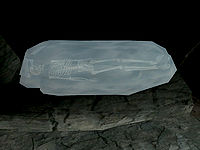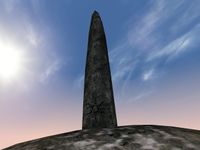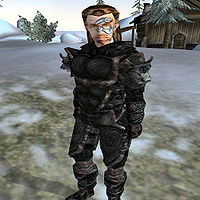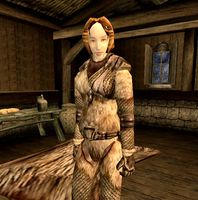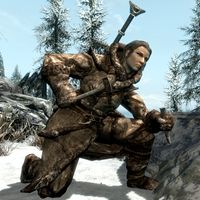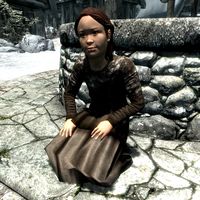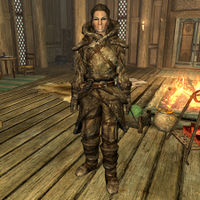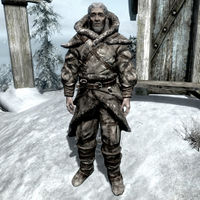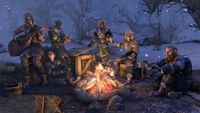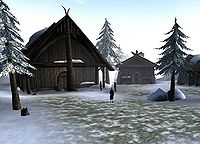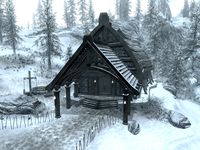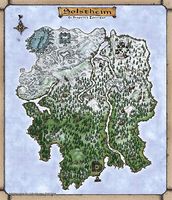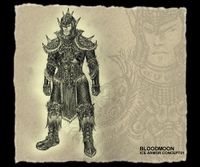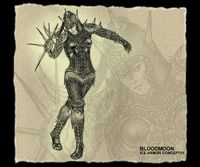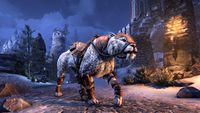Lore:Skaal
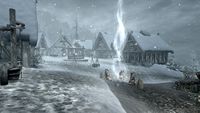
- We are bound to this land, like a great pine with roots that run as deep as the tree is tall. - Frea, Skaal Shaman[1]
The Skaal are an offshoot tribe of Nords living in a village in northeastern Solstheim. They are known as a trusting and hospitable people, welcoming strangers into their village without any suspicion. Their village is located to the east of the Isild River, along the Felsaad Coast just north of Lake Fjalding. The Skaal believe Solstheim was originally part of Skyrim, which was turned into an artificial island during a climactic battle between Dragon Cult loyalists and rebels, with the Skaal being descended from the loyalist faction. Multiple Dragon Cult ruins were uncovered during the Fourth Era, which included carvings that corroborated the oral history preserved by the Skaal.[2] The scholar Tharstan came to the conclusion that the legend described in the Guardian and the Traitor was likely true with the additional archaeological evidence supporting it, and the Skaal formed a distinct culture overtime thanks to the isolation gained from the conflict. [3]
The Skaal are self-sufficient, with the land providing all they require. As such, they rarely accept coin in trade from travelers.[1]
History[edit]
The term "Skaal" first appeared as the name of one of the longships used by the Five Hundred Companions to cross the Sea of Ghosts from Atmora, with the Skaal sailing south-southeast from Atmora through the bitter winds of the Tidal Woe.[4][UOL 1] Visuals carved onto horker scrimshaws depict the early ancestors of the Skaal people running their boats aground on the land of Solstheim.[5]
Early in the third century of the Third Era, a group of Skaal left the village, hoping to return more to their roots. These Skaal were led by Hrothmund the Red, and founded Thirsk Mead Hall, a settlement on the southern shore of Lake Fjalding[6] (though some local Nords believe the history of the hall dates back to the late Second Era[7]). There, they lived like the Nords of old, hunting and fighting without restraint, with the mightiest warrior rising to leadership.[8]
The Imperial Legion at Fort Frostmoth lost a lot of men from conflicts with the local Nords at the end of the Third Era. These Nords, described as "animal-worshipping savages", seemingly had similar beliefs to the Skaal.[9]
Following the Red Year, the ashfall from Red Mountain gradually worsened, poisoning the land and water. This causes animals to have less to eat and become desperate, driven north in search of food, into Skaal lands.[10]
Beliefs and Practices[edit]
Though they are Nords by race, the Skaal embrace their own culture and religion, based around worship of the All-Maker.[11] The Skaal are animists, believing in a creator deity and a variety of spirits throughout the natural world.[UOL 2] They worship the island's wolves and bears, and are known to perform ritual sacrifice by feeding those sentenced to death to the ceremonial Caenlorn Wolves.[12] They believe when something dies, be it an animal or a person, the spirit of the deceased is returned to the All-Maker, who then reforms it into a new being and returns it to the mortal plane, to live out a new life, in a new body. As such, the Skaal do not view death the same way as other Nords. All life is sacred to the Skaal, and they try to live in harmony with nature, impacting their environment as little as possible. They hunt deer, bear, horker, and muskrey, only to the extent necessary for survival, never for enjoyment or practice, and gather their firewood from dead trees that have already fallen.[11][13]
The antithesis of the All-Maker is a being known as the Adversary. The Adversary has many aspects, each one of them designed to test the Skaal, to push them so that they do not become lazy and weak. One aspect of the Adversary is Thartaag, the World-Devourer, likely the Skaal's version of Alduin, the World-Eater. Legend says that Thartaag will return at the End of Seasons, and bring an end to all of creation.[14]
Stalhrim[edit]
The Skaal consider Stalhrim to be holy and infused with divine power, and at one point shunned its usage.[15][16][17][18] They also believe the art of forging Stalhrim into weapons and armor is sacred, and certain members of the Skaal were charged as keepers of this ancient tradition.[19] As such, knowledge of stalhrim smithing is very rare and typically known only to the Skaal. However, local Nords and the warriors of Thirsk have also been known to possess such knowledge.[20][21] The Mace of Aevar Stone-Singer, a prized Skaal artifact, is made from stalhrim.[22]
All-Maker Stones[edit]
The All-Maker stones are an essential part to skaal religion. They represent the most important parts of nature and the greatest gifts of the all maker.
There are six of these standing stones on Solstheim:
- The wind stone
- The beast stone
- The sun stone
- The water stone
- The earth stone
- The tree stone
Beings in Skaal Spirituality[edit]
- The All-Maker
- The Adversary
- The Corrupt Man
- The Greedy Man
- Hircine, a demon god
- Herma Mora, the demon of knowledge.
- Spriggans, came into being when the All-Maker breathed life into the land, and his Breath blew through the trees.[23]
- Spirit Bear
- Thartaag
- The Caenlorn Wolves
Caenlorn Wolves[edit]
The Caenlorn wolves are ceremonial spirit wolves residing in the realm of the All-Maker. The shaman of the Skaal will summon the wolves for executions of criminals. Death by the these wolves is seen as an honorable death and they are able to purify the souls of the convicts, so they can be reborn.[24]
Ristaag[edit]
The Ristaag is a ceremony to cleanse and bless the Skaal tribe in times of great need.[25] The Skaal perform a ritual hunt to please the All-maker. A Spirit Bear, summoned by the sacred totem of claw and fang, needs to be killed, so it's heart can be offered to the All-Maker.[26]
Secrets of the Skaal[edit]
The Skaal guard ancient knowledge, handed down from shaman to shaman. The All-Maker taught them to talk to the wind or how to listen to the earth. And always there has been old Herma-Mora, the demon of knowledge, willing to steal these secrets. The Skaal have many tales of Herma-Mora trying to deceive them into giving him what he wants. These stories also tell of the day when the Skaal will have to give up their secrets and Mora finally wins.[27]
Bloodmoon[edit]
The Skaal also recognize Hircine as an enemy. He is a demon god whose coming is predicted by the Bloodmoon Prophecy, which foretells when he will host the Hunter's Game on Nirn. During this, he walks the lands with his Hounds and chooses which men shall become hares in his hunt.[28]
His children, the Lycanthropes, are viewed as twisted mockeries of the All-Maker's noble creatures.[29] They believe that Man was not meant to live a dual life as both rational being and animal.[28]
The Skaal believe a mummified wolf paw capped at the ankle with silver can ward away werewolves.[30]
Skaal Legends[edit]
The Traitor[edit]
According to legend, long ago the world was ruled by dragons, who enslaved the race of man and forced them to build fantastic temples in their honor. Directing the slaves in their name were the Dragon Priests, a group of men who worshipped the dragons and were given power in exchange for their devotion. These priests were powerful mages, and had the gift of the Thu'um. One of these dragon priests, known only as the Traitor, was seduced by Herma-Mora, the Skaal's name for the Daedric Prince Hermaeus Mora. His plot to overthrow the dragons was discovered by another dragon priest, known as the Guardian. The Guardian confronted the Traitor, and the two fought a terrible battle. So great was their power, Solstheim was sundered from Skyrim. The Guardian proved to be the more powerful, and bested the Traitor. Just as the Guardian was about to land the final blow, Herma-Mora snatched the Traitor away, rescuing him from certain death. As a reward for his loyalty, the Guardian was given Solstheim to rule, where his reign is remembered as peaceful and prosperous, and he is remembered as a wise and just ruler.[2]
Aevar[edit]
In another tale, originating from when the Skaal were a new people, the land was at peace. The sun was warm, and the groups bountiful, and all the Skaal gave thanks to the All-Maker. Over time, however, the Skaal gave less and less thanks, becoming complacent and lazy. They forgot that the Adversary, the antithesis of the All-Maker, is always watching, waiting for a chance to torment the All-Maker and his preferred people. Unlike the All-Maker, the Adversary has many aspects, each one with a specific name and gender. At this time, he was known as the Greedy Man. The Greedy Man lived among the Skaal for some time, until one day the powers of the Skaal suddenly disappeared. The warriors became weak, the shaman could no longer call to the beasts of the forest for aid. The elders of the Skaal thought that the All-Maker had abandoned them, and this is when the Greedy Man spoke. He told them that because of their disregard for the gifts of the All-Maker, he had taken them away. He told them that until one among them could retrieve the gifts of the All-Maker, all of the Skaal would live in misery, and then he disappeared. The Skaal spoke well into the night, and then into the next day, and continued to talk until many days passed. They knew that someone must go, but none of them wanted to bear the responsibility. It was then that a young man named Aevar spoke, and volunteered to go. He traveled into the forest, to each of the All-Maker Stones, meditating at each of them, and learned from the All-Maker how he might retrieve the gifts from the Greedy Man. He traveled across Solstheim, and retrieved all of the gifts from the Greedy Man. He meditated again, and the All-Maker spoke to him, telling them that he was pleased, and that the Greedy Man would not bother the Skaal again for many years to come. With that, Aevar returned to the Skaal, and lived according to the true ways of the Skaal.[14]
Magic Users[edit]
Frostcasters[edit]
The Frostcasters are Skaal shamans of All-Maker known for their mastery of Frost Magic. Not all Skaal shamans are Frostcasters; the title is reserved for those who specialize in Frost Magic. They were known to skillfully integrate Stalhrim into their arms and armor, creating decorative pieces.
Windcallers[edit]
The Windcallers, also known as the Blessed of the All-Maker are Skaal witches who adeptly invoke the winds. They are distinguished by delicate markings on their faces and are renowned for their creature companions. Circlets worn by them feature stalhrim nestled between wolf embellishments, symbolizing their connection to the winds and their trained wolf guardians. The flowing body art of a Solstheim Windcaller reflects the breezes and gusts of air accompanying them on their journeys, with some believing these marks tell a tale of self-discovery along the path set by the All-Maker.
Leaders of the Skaal[edit]
- Tharsten Heart-Fang, leader of the Skaal, circa 3E 427
- Skaf the Giant, leader of the Skaal before Fanari
- Fanari Strong-Voice, leader of the Skaal circa 4E 201
Gallery[edit]
Appearances[edit]
Miscellaneous[edit]
Skaal Village circa 3E 427 (Morrowind)
Notes[edit]
- The name skaal likely comes from the obsolete typography of the Old Norse word skål (IPA: [ˈskɔːl]), which directly translates to bowl, but was used as a toast, akin the English cheers.
See Also[edit]
- For game-specific information on the Skaal people, see the Bloodmoon article.
- For game-specific information on the village, see the Bloodmoon and SkyrimDB articles.
References[edit]
- ^ a b Frea's dialogue in Skyrim: Dragonborn
- ^ a b The Guardian and the Traitor — Lucius Gallus
- ^ Tharstan's dialogue in Skyrim: Dragonborn
- ^ Songs of the Return, Vol 7
- ^ Skaal-Carved Horker Tusk item description in ESO
- ^ Thirsk, a History — Bereditte Jastal
- ^ Thirsk residents' dialogue in Morrowind: Bloodmoon
- ^ Kuvar's dialogue in Skyrim: Dragonborn
- ^ Neville's dialogue in Oblivion
- ^ Wulf Wild-Blood's dialogue in Skyrim: Dragonborn
- ^ a b Children of the All-Maker — Tharstan of Solitude
- ^ The Skaal Test of Wisdom quest in Morrowind: Bloodmoon
- ^ Lord of Souls — Greg Keyes
- ^ a b The Story of Aevar Stone-Singer
- ^ Graring's dialogue in Morrowind: Bloodmoon
- ^ Hidar's dialogue in Morrowind: Bloodmoon
- ^ Aenar's dialogue in Morrowind: Bloodmoon
- ^ Brazier of Frozen Flame Antiquity Codex entries in ESO: Greymoor
- ^ Deor Woodcutter's dialogue in Skyrim: Dragonborn
- ^ Loading screens in Skyrim: Dragonborn
- ^ Skaal Amulet in Skyrim: Dragonborn
- ^ Events of Morrowind: Bloodmoon
- ^ Skaal Village residents' dialogue about Spriggans in Morrowind: Bloodmoon
- ^ Dialogue with Heart-Fang about the wolves in Morrowind: Bloodmoon
- ^ Cleansing ceremony in Morrowind: Bloodmoon
- ^ Summoned by totem of claw and fang in Morrowind: Bloodmoon
- ^ Storns dialogue in 'The gardener of men' in Skyrim: Dragonborn
- ^ a b Korst Wind-Eye's dialogue in Morrowind: Bloodmoon
- ^ Wulf Wild-Blood's dialogue in Skyrim: Dragonborn
- ^ Gnarled Paw item description in ESO
Note: The following references are considered to be unofficial sources. They are included to round off this article and may not be authoritative or conclusive.
| ||||||||||||||||||||||||||||||||||||||||||||||||||||||||||||||||||
